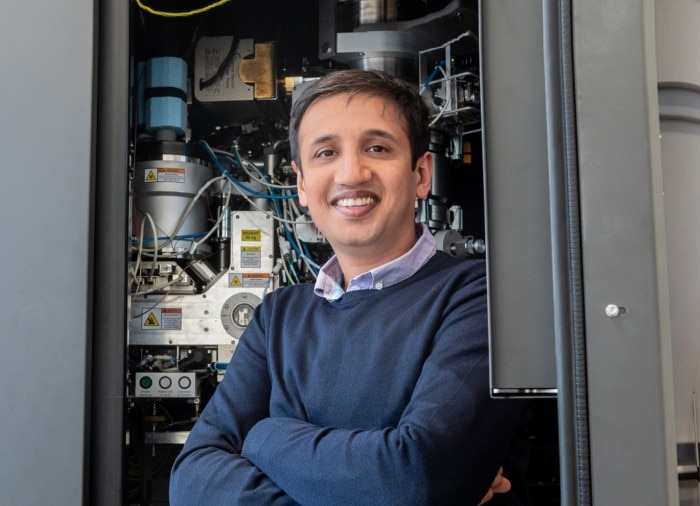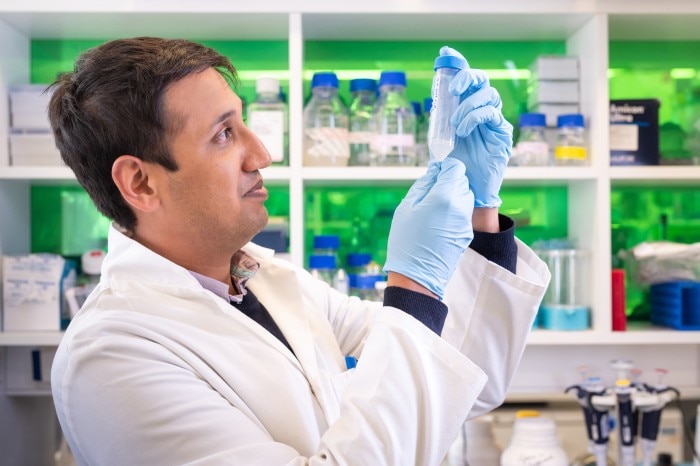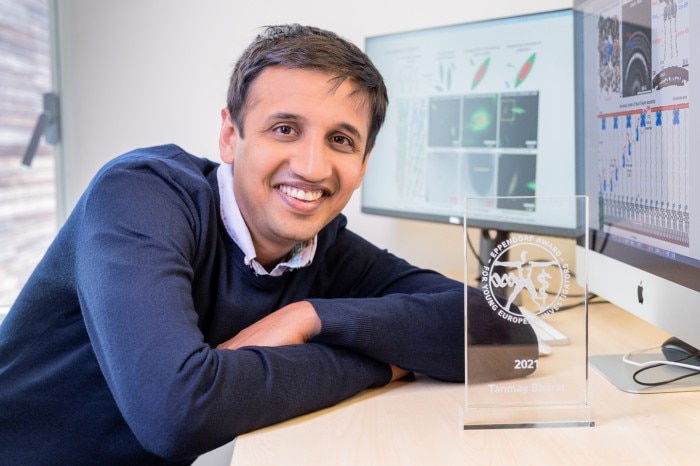MENU
TH | THB
TH | THB
-
- Benchtop Centrifuges
- Floor-Standing Centrifuges
- Refrigerated Centrifuges
- Microcentrifuges
- Multipurpose Centrifuges
- High-Speed Centrifuges
- Ultracentrifuges
- Concentrator
- High-Speed and Ultracentrifugation Consumables
- Accessories
- Tubes
- Plates
- Device Management Software
- Sample and Information Management
No results found
Search Suggestions

A Dangerous Game of Hide-and-Seek
Beyond Science
- Research
- Off the Bench
- Off the Bench
- Bright Minds
It is a race against time: more and more bacteria are developing resistance to antibiotics. How do they do that? Molecular biologist Tanmay Bharat of Oxford University was able to uncover some of their mechanisms.
Are bacteria actually living
organisms? Bacteria comprise a single cell; they do not possess a nucleus, and yet, they have at their disposal all the necessities of life: genetic material as well as proteins which provide the food for their metabolism. And, of course, they are capable of procreation by cell division. Even though they do quite well on their own, they prefer the company of other bacteria. Most bacteria collaborate, thereby setting in motion the processes that cause illness in humans. Throughout, they tend to resort to cunning methods; they play hide-and-seek with possible adversaries such as antibiotic medications.
Pathogen specialist
Tanmay Bharat specializes in the study of these microscopic organisms. The molecular biologist observes bacterial cultures in detail. Born in New Delhi, the 36-year-old came to Oxford on a scholarship to support the completion of his biology degree. He subsequently moved to the European Molecular Biology Laboratory (EMBL) in Heidelberg for his PhD in order to study viruses – namely Ebola and HIV – which are log scales smaller than bacteria. As a postdoc, he started out in Cambridge and shortly thereafter moved to the Sir William Dunn School of Pathology on the Oxford University campus. For the past four years, the young scientist has headed his own laboratory with 14 members (before the pandemic). COVID-measures have reduced his lab to ten members.
During our conversation, he refers to both current and historic context. It was at this very university that an academic laboratory, in collaboration with a pharmaceutical company, developed the COVID vaccine Astra Zeneca in record time. Likewise, prior to the second world war, penicillin, the first antibiotic ever, was launched in Oxford and subsequently distributed across the world, which, according to Bharat, “significantly changed human history.” The ambitious researcher is inspired by his professional surroundings, and he considers his work as a molecular biologist to be an absolute dream job. It is therefore not surprising that the ambitions of the soon-to-be father of two aim high. His goal: offering the next big blockbuster antibiotic to the world. And how does he relax? “Once you are dealing with children and changing diapers it’s hard to think of antibiotics”, he says with a smile.
organisms? Bacteria comprise a single cell; they do not possess a nucleus, and yet, they have at their disposal all the necessities of life: genetic material as well as proteins which provide the food for their metabolism. And, of course, they are capable of procreation by cell division. Even though they do quite well on their own, they prefer the company of other bacteria. Most bacteria collaborate, thereby setting in motion the processes that cause illness in humans. Throughout, they tend to resort to cunning methods; they play hide-and-seek with possible adversaries such as antibiotic medications.
Pathogen specialist
Tanmay Bharat specializes in the study of these microscopic organisms. The molecular biologist observes bacterial cultures in detail. Born in New Delhi, the 36-year-old came to Oxford on a scholarship to support the completion of his biology degree. He subsequently moved to the European Molecular Biology Laboratory (EMBL) in Heidelberg for his PhD in order to study viruses – namely Ebola and HIV – which are log scales smaller than bacteria. As a postdoc, he started out in Cambridge and shortly thereafter moved to the Sir William Dunn School of Pathology on the Oxford University campus. For the past four years, the young scientist has headed his own laboratory with 14 members (before the pandemic). COVID-measures have reduced his lab to ten members.
During our conversation, he refers to both current and historic context. It was at this very university that an academic laboratory, in collaboration with a pharmaceutical company, developed the COVID vaccine Astra Zeneca in record time. Likewise, prior to the second world war, penicillin, the first antibiotic ever, was launched in Oxford and subsequently distributed across the world, which, according to Bharat, “significantly changed human history.” The ambitious researcher is inspired by his professional surroundings, and he considers his work as a molecular biologist to be an absolute dream job. It is therefore not surprising that the ambitions of the soon-to-be father of two aim high. His goal: offering the next big blockbuster antibiotic to the world. And how does he relax? “Once you are dealing with children and changing diapers it’s hard to think of antibiotics”, he says with a smile.
Read more
Read less

Antibiotic resistance – a “slow pandemic”
His drive is not fueled solely by the spirit of his inspiring academic environment, but it is also of a personal nature. “My work is directly related to my biography”, emphasizes Tanmay Bharat. As a child in India, he contracted a bone infection – a disease that continues to cause him problems: he needs to undergo repeated surgeries, the most recent of which occurred shortly after starting his laboratory in Oxford. “I hope this will be the end of it.”
This bridge between illness and his studies is reminiscent of a natural race against time; at the same time, his personal affliction makes up only a part of his motivation. Tanmay Bharat considers the bigger picture. He places science in a direct relationship with society; throughout his scientific career, he has continuously taken up the most relevant topics. The latest: the fight against AIDS and Ebola. He considers the growing resistance to antibiotics a “threatening pandemic” which is simply unfolding at a slower pace than the COVID-19 catastrophe. “When antibiotics cease to be effective, our medical system will be catapulted back into the Middle Ages.”
Together with his team, Bharat has been able to shine a light on the many aspects of bacteria, and he promises: “Our fundamental research will contribute to the development of strategies for the therapeutic intervention against bacterial infections.” This is one of the reasons why he is excited to be awarded the Eppendorf Award for Young European Investigators 2021, worth 20,000 euros. This is a “very prestigious prize” in Europe, which elevates his research into the spotlight. The most difficult hurdle that young researchers face is to be noticed among the crowd.
His drive is not fueled solely by the spirit of his inspiring academic environment, but it is also of a personal nature. “My work is directly related to my biography”, emphasizes Tanmay Bharat. As a child in India, he contracted a bone infection – a disease that continues to cause him problems: he needs to undergo repeated surgeries, the most recent of which occurred shortly after starting his laboratory in Oxford. “I hope this will be the end of it.”
This bridge between illness and his studies is reminiscent of a natural race against time; at the same time, his personal affliction makes up only a part of his motivation. Tanmay Bharat considers the bigger picture. He places science in a direct relationship with society; throughout his scientific career, he has continuously taken up the most relevant topics. The latest: the fight against AIDS and Ebola. He considers the growing resistance to antibiotics a “threatening pandemic” which is simply unfolding at a slower pace than the COVID-19 catastrophe. “When antibiotics cease to be effective, our medical system will be catapulted back into the Middle Ages.”
Together with his team, Bharat has been able to shine a light on the many aspects of bacteria, and he promises: “Our fundamental research will contribute to the development of strategies for the therapeutic intervention against bacterial infections.” This is one of the reasons why he is excited to be awarded the Eppendorf Award for Young European Investigators 2021, worth 20,000 euros. This is a “very prestigious prize” in Europe, which elevates his research into the spotlight. The most difficult hurdle that young researchers face is to be noticed among the crowd.
Read more
Read less

Bacteria build biofilms
According to the jury, Bharat was awarded the prize for “his groundbreaking research in the field of antibiotic resistance”. What did he discover? Put simply, he observed how certain bacteria collaborate and how it is possible to block their deadly deed. Since bacteria are tiny – between 0.0001 and 0.8 millimeters in diameter – specialists operate in dimensions that are all but inconceivable to the layperson. State-of-the-art laboratories are equipped with electron microscopes; resolution achieved with these microscopes for biological specimens is now approaching 0.1 nm, which means one billionth of a meter. “Even from a technological perspective, these are incredibly exciting times”, says Tanmay Bharat. It was only high-resolution imaging technology that was capable of providing answers about bacterial cell biology. The researchers were now observing bacteria in their natural habitats – as if through a keyhole.
Enjoying eureka moments
They could see how communities of bacteria form biofilms and embed themselves in a kind of protective matrix. Bharat illustrates that the bacteria secrete certain molecules and deposit them in their vicinity. What looks like a slimy string turns out to be a protective barrier against antibiotics. This biofilm lifestyle allows the bacteria to enter a metabolically inactive state during which they power down their metabolism to such an extent that they internalize hardly any antibiotic molecules. The medication cannot do them any harm. Bharat’s team, however, has been able to successfully generate antibodies which block the protective effect provided by the slime barrier, and block biofilm formation. “When bacteria return to the single-cell state, they are susceptible to killing by antibiotics.” This can easily be achieved with the current generation of antibiotics.
He enjoys such “eureka-moments”, but also the process itself. “This, to me, is not work – it is more of a hobby, no, my life”, says Tanmay Bharat, whose best ideas come to him during conversations with colleagues. The only thing that is needed now before clinical trials can begin, and thus for society to enjoy a practical benefit as soon as possible, is a pharmaceutical collaborator. After all, the COVID-19 pandemic has shown that “where there is a need, things can move very quickly.” Within a year from now, it might be possible – he pauses briefly – no, it will most likely take a little longer …
According to the jury, Bharat was awarded the prize for “his groundbreaking research in the field of antibiotic resistance”. What did he discover? Put simply, he observed how certain bacteria collaborate and how it is possible to block their deadly deed. Since bacteria are tiny – between 0.0001 and 0.8 millimeters in diameter – specialists operate in dimensions that are all but inconceivable to the layperson. State-of-the-art laboratories are equipped with electron microscopes; resolution achieved with these microscopes for biological specimens is now approaching 0.1 nm, which means one billionth of a meter. “Even from a technological perspective, these are incredibly exciting times”, says Tanmay Bharat. It was only high-resolution imaging technology that was capable of providing answers about bacterial cell biology. The researchers were now observing bacteria in their natural habitats – as if through a keyhole.
Enjoying eureka moments
They could see how communities of bacteria form biofilms and embed themselves in a kind of protective matrix. Bharat illustrates that the bacteria secrete certain molecules and deposit them in their vicinity. What looks like a slimy string turns out to be a protective barrier against antibiotics. This biofilm lifestyle allows the bacteria to enter a metabolically inactive state during which they power down their metabolism to such an extent that they internalize hardly any antibiotic molecules. The medication cannot do them any harm. Bharat’s team, however, has been able to successfully generate antibodies which block the protective effect provided by the slime barrier, and block biofilm formation. “When bacteria return to the single-cell state, they are susceptible to killing by antibiotics.” This can easily be achieved with the current generation of antibiotics.
He enjoys such “eureka-moments”, but also the process itself. “This, to me, is not work – it is more of a hobby, no, my life”, says Tanmay Bharat, whose best ideas come to him during conversations with colleagues. The only thing that is needed now before clinical trials can begin, and thus for society to enjoy a practical benefit as soon as possible, is a pharmaceutical collaborator. After all, the COVID-19 pandemic has shown that “where there is a need, things can move very quickly.” Within a year from now, it might be possible – he pauses briefly – no, it will most likely take a little longer …
Read more
Read less

